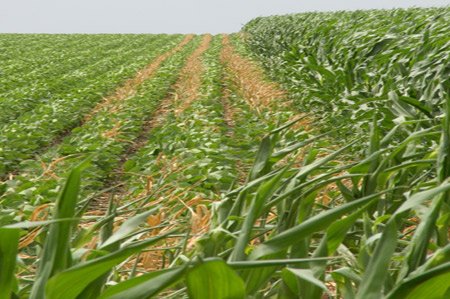 (Agriculture.com) – Grain prices will again entice farmers to plant a lot of corn and soybeans this year, but if Mother Nature cooperates and those large plantings translate to large crop output by the season’s end, it could lead to lower returns — and ultimately, overall output — further down the road.
(Agriculture.com) – Grain prices will again entice farmers to plant a lot of corn and soybeans this year, but if Mother Nature cooperates and those large plantings translate to large crop output by the season’s end, it could lead to lower returns — and ultimately, overall output — further down the road.
That’s the main finding for U.S. crop prospects in the USDA Long-term projections released Monday. Demand will remain strong enough to support a bigger crop this year, but that may not be sustainable beyond the next couple of years, the report shows.
“In the short term, the U.S. crops sector responds to continuing high prices for most crops in 2012/13. Planted area for the 8 major field crops in 2013 is projected at more than 254 million acres. While that is down from the large acreage planted in 2012 when favorable spring weather combined with strong economic incentives, 2013 plantings would be the second largest acreage since 2000. As U.S. and global supplies rebound and prices decline for most crops, U.S. planted acreage for these crops is projected to fall over the next several years in response to lower producer returns,” according to Monday’s report. “Over the longer run, steady global economic growth provides a foundation for continuing strong crop demand. Prices are projected to fall from recent record highs but remain above pre-2007 levels for many crops. Following the near-term decline in prices and planted acreage, strong demand and rising prices provide economic incentives for increases in plantings beyond 2015.”
USDA expects these conditions to remain intact based on an expected rebound in ethanol production, better world economic conditions, a depreciating U.S. Dollar and growing renewable fuels production on a global scale. They’ll all help encourage more corn use, which has curtailed in recent months, USDA’s report shows.
“Lower supplies and higher prices resulting from weather-reduced 2012 U.S. corn production have led to lower domestic use and exports. Corn acreage is projected to remain high in the near term, with normal yields leading to an increase in production and a recovery of corn use,” according to the report. “Although corn-based ethanol production is projected to slow significantly, its continued high levels combine with gains in exports and feed use to keep corn use high. Following several years of adjusting markets, increasing producer returns lead to gradually rising corn acreage in a range of 88 million to 92 million acres after 2015.”
Soybeans are expected to track the trend in corn, the report adds. “Strengthening demand for soybeans and soybean products holds soybean prices high throughout the projection period. Similar to the price projections for corn, after near-term market adjustments reduce soybean prices from recent highs, prices for soybeans rise moderately after 2014/15 through the rest of the projection period.”
In the livestock sector, the drought of 2012 and whatever may remain of it in the coming year will continue to send the beef herd lower until feed costs moderate. And, a return to higher herd numbers will likely come after 2015, at which point production declines brought on by lower breeding inventories can work themselves out.
“Despite improved returns for cow-calf operators in 2011 and 2012, drought over the past two years will prevent producers from expanding beef cow inventories until 2014. Lower beef cow inventories and expected heifer retention are expected to lead to declines in beef production through 2015. Production then rises in the remainder of the projection period as returns support herd expansion,” USDA’s report says. “Beef cow numbers rise from about 30 million head at the beginning of 2014 to 33 million in the last several years of the projection period. The total cattle inventory drops to 89 million head at the beginning of 2014 before expanding to about 94 million at the end of the projection period. Rising slaughter weights also contribute to the longer term increases in beef production.”




